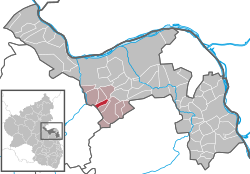Welgesheim
| Welgesheim | ||
|---|---|---|
|
||
| Coordinates: 49°52′56″N 07°57′43″E / 49.88222°N 7.96194°ECoordinates: 49°52′56″N 07°57′43″E / 49.88222°N 7.96194°E | ||
| Country | Germany | |
| State | Rhineland-Palatinate | |
| District | Mainz-Bingen | |
| Municipal assoc. | Sprendlingen-Gensingen | |
| Government | ||
| • Mayor | Michael Leisenheimer (CDU) | |
| Area | ||
| • Total | 2.03 km2 (0.78 sq mi) | |
| Elevation | 105 m (344 ft) | |
| Population (2015-12-31) | ||
| • Total | 570 | |
| • Density | 280/km2 (730/sq mi) | |
| Time zone | CET/CEST (UTC+1/+2) | |
| Postal codes | 55576 | |
| Dialling codes | 06701 | |
| Vehicle registration | MZ | |
| Website | www.welgesheim.de | |
Welgesheim is an Ortsgemeinde – a municipality belonging to a Verbandsgemeinde, a kind of collective municipality – in the Mainz-Bingen district in Rhineland-Palatinate, Germany.
Welgesheim lies in Rhenish Hesse between Mainz and Bad Kreuznach. It belongs to the Verbandsgemeinde of Sprendlingen-Gensingen, whose seat is in Sprendlingen.
Welgesheim lies on the spot where once the old military road crossed the river Wiesbach. During excavation work several graves were unearthed, leading to the conclusion that there was once a Roman settlement in what is now Welgesheim’s municipal area.
The place called Wellingesheim itself had its first documentary mention in 770 in the Lorsch codex. In 874 it appeared under the name Willengisheim and in 1178 as Wellengesheim. Under its current name it appeared about 1194, when Werner von Bolanden was enfeoffed with the church treasure at Welgesheim by Count Lon.
Later, Welgesheim belonged to the lordly domain of the Elector of the Palatinate, with whom the place remained until the late 18th century.
Under Napoleon, Welgesheim belonged as part of the department of Mont-Tonnerre (Donnersberg) from 1801 to 1814 to France, with its attendant laws, such as the Napoleonic code.
In the wake of the Congress of Vienna in 1814 and 1815, the Rhenish-Hessian area was awarded to Hesse-Darmstadt, thereby likewise putting Welgesheim in the Grand Duchy of Hesse-Darmstadt, which was surrounded by the Bavarian Palatinate in the south, the Prussian Governmental Region of Koblenz in the west and the Duchy of Nassau in the north.
...
Wikipedia



